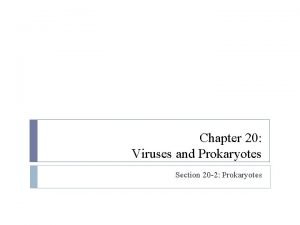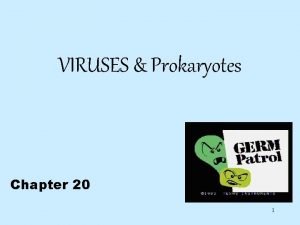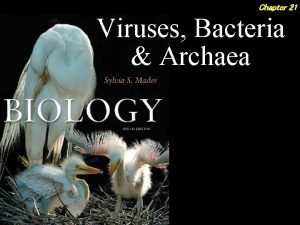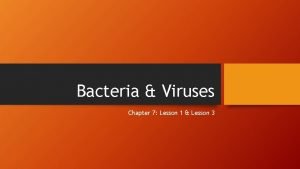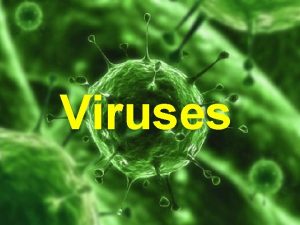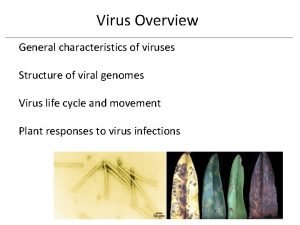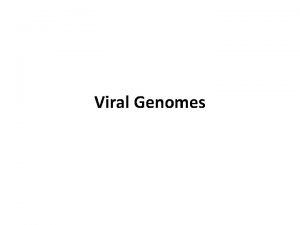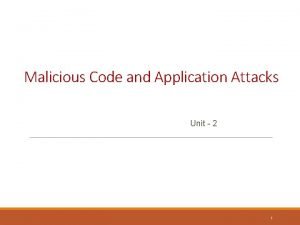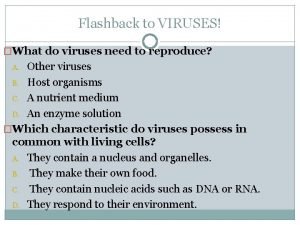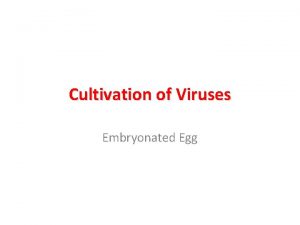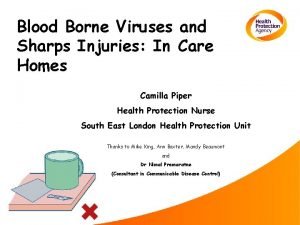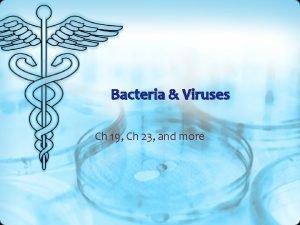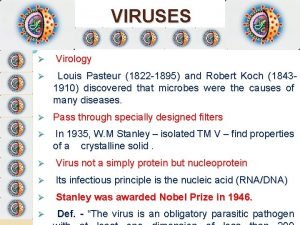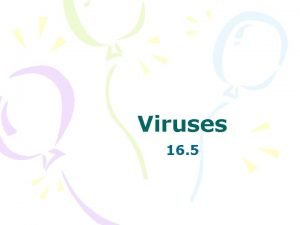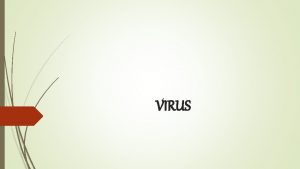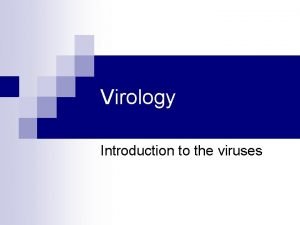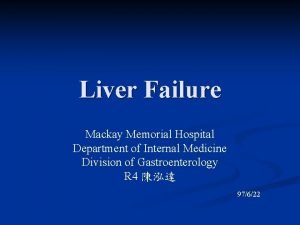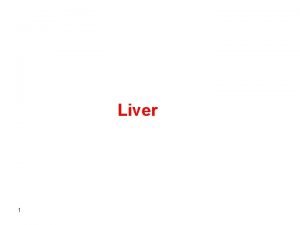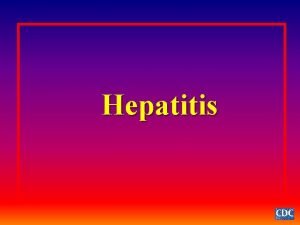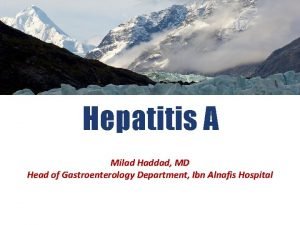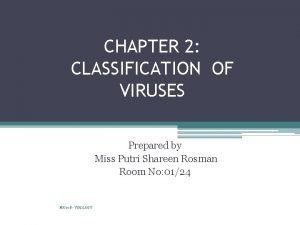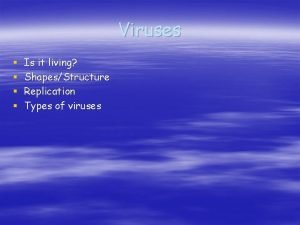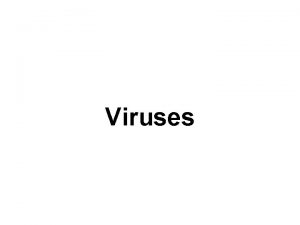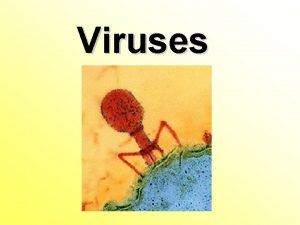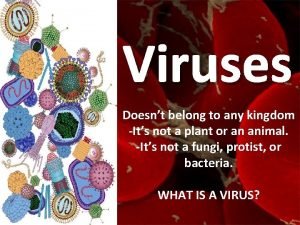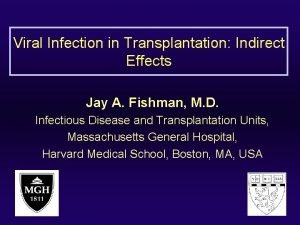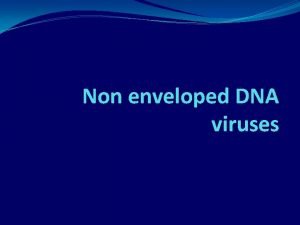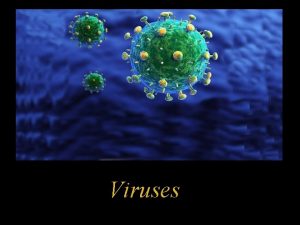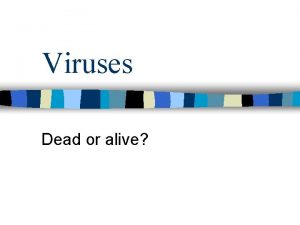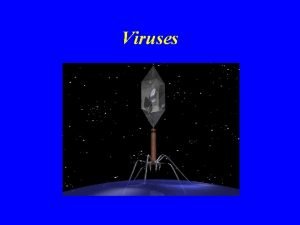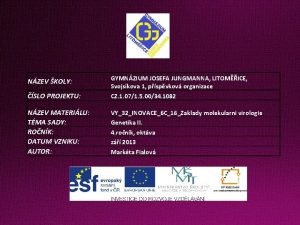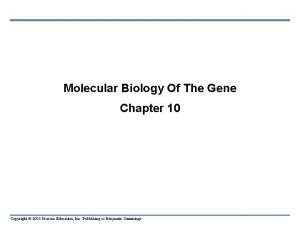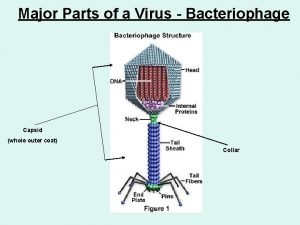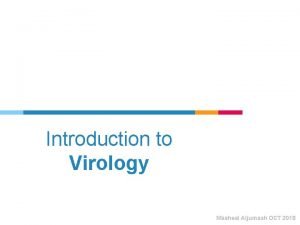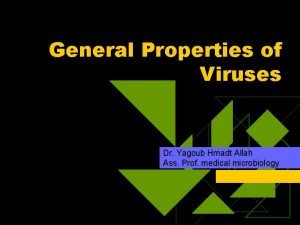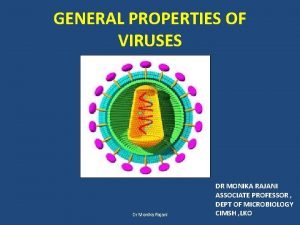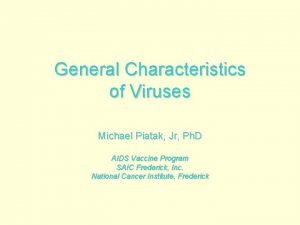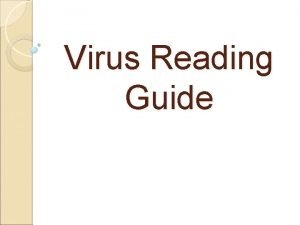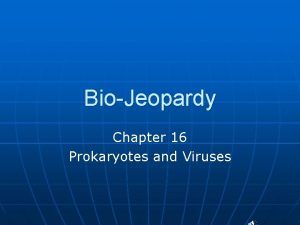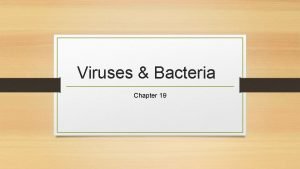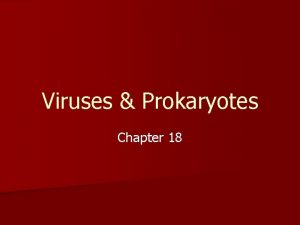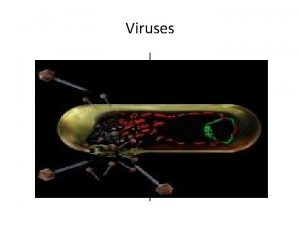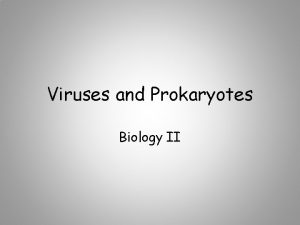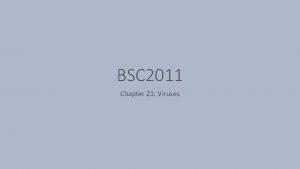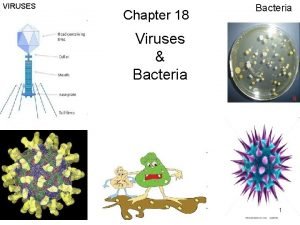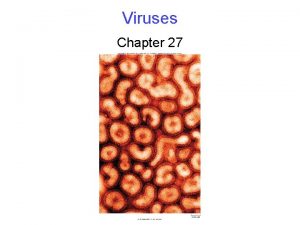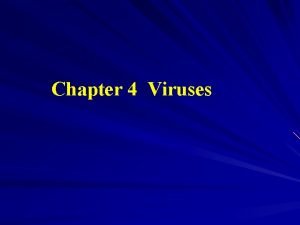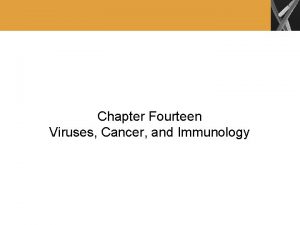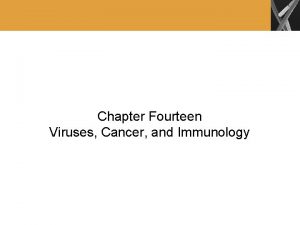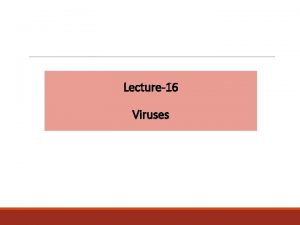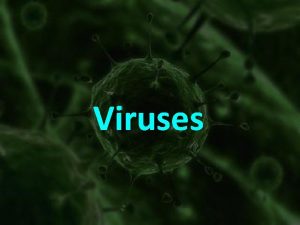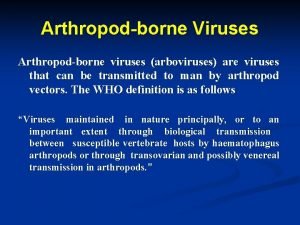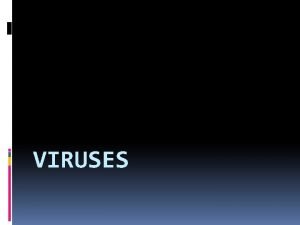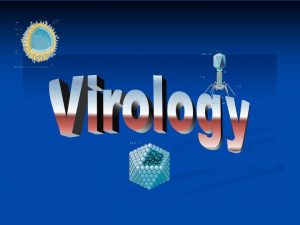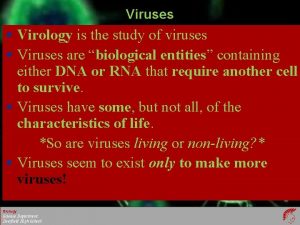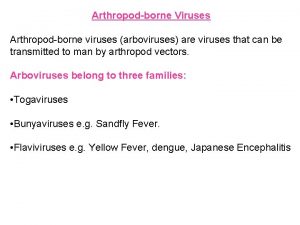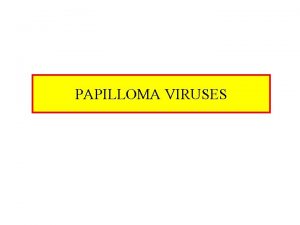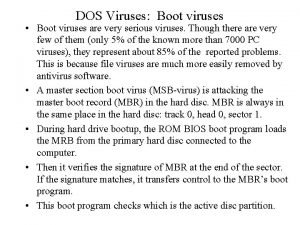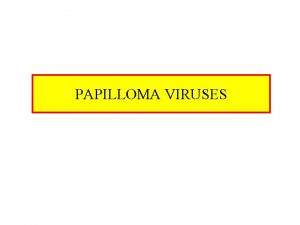VIRUSES Prokaryotes Chapter 20 1 2 The Structure














































- Slides: 46

VIRUSES & Prokaryotes Chapter 20 1

2

The Structure of Bacteria • 3 basic shapes: rod, spherical & spiralshaped • No nucleus • Cell wall • Flagella or cilia for movement 3

How Bacteria Obtain Energy • Some make their own food (like plants). • Some obtain their food (like us). These bacteria eat the nutrients in the agar. 4

Reproduction in Bacteria • Most reproduce through binary fission (asexual reproduction), making clones. 5

• Other bacteria exchange genetic information through conjugation (a. k. a. bacteria sex). • A hollow bridge forms between the 2 bacteria & genes move from 1 bacterium to the other. • The advantage- it increases genetic diversity. 6

• Bacteria that causes illness and disease. Ex: diphtheria, tuberculosis, typhoid fever, tetanus, syphilis, cholera, bubonic plague • How are the diseases caused? – Bacteria damage the cells & tissues of an organism by breaking them down for food. or – Bacteria release toxins (poisons) that travel through the organism’s body. 7

• Bacteria that humans use and need in their everyday lives. Escherichia coli (Esh-er-ish-e-ah coal-eye): one of many that live in your gut. Helps digest your food. 8

Lactobacillus acidophilus (lack-toe-bah -sill-us acid-off-ill-us): Turns milk into yogurt. Saccharomyces cerevisiae (sack-arrow-my-seas sairuh-vis-ee-ay): a. k. a. baker's yeast. Makes bread rise. Pseudomonas putida (suedoe-moan-us poo-teadah): Cleans wastes from sewage water at water treatment plants. 9

Streptomyces (streptoe-my-seas): soil bacteria that makes streptomycin, an antibiotic. Arbuscular mycorrhizas (ar-bus-que-ler my-kuhrye-zuh): one of a soilliving fungus family. Helps crops take up nutrients from the soil. Bacillus thuringiensis (bah-sill-us ther-in-gee-in-sis): a. k. a "Bt", a common soil bacterium. A natural pest-killer in gardens and on 10 crops.

Bacteria are Useful for: • • Nitrogen Fixation Recycling of Nutrients (decomposers) • • Foods & Medicines Producers Ex: Prochlorococcus accounts for more ½ of photosynthesis in open oceans. Antibiotics 11

How Do You Treat a Bacterial Infection? • If prevention fails, take antibiotics. • Antibiotics kill bacteria without harming the cells of humans or animals. – They interfere with the cellular processes of bacteria. • Many antibiotics are produced naturally by living organisms. Ex: penicillin • Others are synthetic (man-made). 12

13

Virus Facts • NONLIVING: can’t grow, develop, or respire and cannot replicate on their own. • ½ to 1/100 the size of the smallest bacterium. 14

What do viruses look like? • Made of a core of genetic material surrounded by a protein coat (capsid). • Come in a variety shapes: rod or tadpoleshaped; helical; cube like 15

How do viruses reproduce? • Viruses insert their genetic material into a host cell. – The capsid (outside protein) “tricks” the cell into allowing it inside. • Once inside, the viral genes take over. • The “hijacked” cell transcribes the viral genes, using the host cells own enzymes. • Lytic or Lysogenic Cycles 16

Viral Replication Cycles Lytic cycle: Virus infects the cell, copies itself & causes the host cell to burst (lyse). • ex: influenza (flu), cold, rabies, AIDS Lysogenic cycle: Virus infects the cell & inserts its genetic material into the hosts DNA. The host cell is not harmed. • ex: Herpes, Varicella (chicken pox), HIV http: //www. youtube. com/watch? v=Rpj 0 em. EGSh. Q

• Because viruses bind precisely to proteins on the host cell’s surface & use it’s genetic system, most viruses infect very specific types of cells. Ex: plant viruses infect plant cells, bacterial viruses infect bacteria (bacteriophages) 18

RETROVIRUSES • Contain RNA as their genetic material. Ex: HIV • Retroviruses infect a cell and produce a DNA copy of their RNA. (retro = backward; RNA is copied in to DNA) • This DNA is inserted into the host cell's DNA. 19

How Can You Protect Yourself From Viral Infections? • The best way: vaccines – Weakened or killed virus or viral proteins. – When injected, the vaccine stimulates the immune system. – Sometimes produces permanent immunity. • Protect yourself! – Stay away from known sick people. – Wash your hands often. 20

The Immune System and Disease Chapter 35

Infectious Disease 22

infectious disease: changes to body physiology that disrupt normal body functions caused by microorganisms pathogen: a disease-causing agent; causes infection -includes viruses, fungi, bacteria, protozoans & parasites

How are Diseases Spread? • • Coughing, sneezing, physical contact Exchange in body fluids Contaminated food & water Animal contact (zoonosis) – vector: animal carrier who transmits the disease, but doesn’t get sick themselves.

Defense Against Infection 25

Nonspecific Defenses • General defense against many different pathogens. • Include skin, tears & other secretions, inflammatory response, interferons & fever.

First Line of Defense ● Include skin, saliva, mucus, & tears. ● As long as they remain intact, they can keep out many pathogens.

Second Line of Defense 1. ) interferons: chemicals released by virusinfected cells that slow down the progress of infection & buy time for the immune system to respond 2. ) fever: higher body temperature slows down or stops the growth of some pathogens

3) inflammatory response • A tissue response to injury or infection, producing redness, swelling, heat & pain. • Chemicals released by damaged tissues attract white blood cells to the site. • The mass of white blood cells, bacterial cells & damaged tissue forms pus.

Specific Defenses = the Immune System • Very precise. • Recognize “self” & “other” (& kill the “other”). • Also known as immune response. • Slower to respond than non-specific defenses.

Antigens & Antibodies antigen: specific foreign molecules that trigger an immune response; usually located on a cell’s surface antibodies: tag antigens for destruction by the immune system – Shape allows it to bind to specific antigen. Body makes up to 10 billion different antibodies. – Antibodies may be free floating or attached to B cells.

Lymphocytes (White Blood Cells) Two Types: B cells • Produced & mature in red bone marrow. • Have embedded antibodies. • Discover antigens in body fluids. T cells • Produced in bone marrow & mature in thymus. • Must be presented with antigens by infected body cells or immune cells.

The Immune System • Two main types of specific immune response: 1. ) humoral immunity (pathogen is in fluids) 2. ) cell-mediated immunity (pathogen has invaded a cell) 33

Humoral Immunity 1. ) Antibodies on B cells bind to antigens in body fluids (like blood & lymph). 2. ) This stimulates rapid growth & division of B cells, both Plasma & Memory B cells. 3. ) Plasma B cells make more antibodies that tag the antigens for destruction. 4. ) Memory B cells remain alive after infection ends & quickly produce more Plasma B cells if the pathogen returns. (Why vaccinations work!) 34

Cell-mediated Immunity • T cells destroy body cells containing viruses, fungi & cancer. 1. ) Infected cell displays antigen on its outer surface. 2. ) T cells are activated & kill infected cells. 3. ) Memory T cells are also produced to respond quickly if the pathogen returns. • This is what causes organ rejection. 35

Fighting Infectious Disease & Health 36

Vaccination • Consists of pathogens that have been weakened or killed so they cannot cause a serious infection. • Includes antigens that stimulate an immune response, but do not produce the severe symptoms of disease.


Acquired Immunity Active Immunity: Person produces an immune response to the antigen (including memory B & T cells) from either direct exposure (fighting the infection) or vaccination. Passive Immunity: Antibodies produced against a pathogen by other individuals or animals produce temporary immunity. Ex: rabies antibody serum, mother to fetus, breast milk

Public Health Prevention of Diseases Spreading 1. ) Regulating food and water supplies. – Cholera, Typhoid, Guinea worm

Public Health Prevention of Diseases Spreading 2. ) Promoting vaccinations. • Herd Immunity

Herd Immunity

Public Health Prevention of Diseases Spreading 3. ) Promoting behaviors that avoid spread of infection.

New and Re-Emerging Diseases • Many diseases were eliminated or were under control in the 1980 s (e. g. polio & smallpox). • Over the past decade, we have had a resurgence of old diseases and introduction of new diseases (Ebola, SARS, hantavirus). • Why has this happened? ?

Reasons for New and Re. Emerging Diseases 1. ) Changing interactions with Animals: – Human & animal habitats combine. – Trade of exotic animals.

Reasons for New and Re. Emerging Diseases 2. ) Misuse of Antibiotics & medications: – Not following instructions on medication. – Overuse of antibiotics is causing resistance. P a n d e m i c s
 Chapter 20 viruses and prokaryotes
Chapter 20 viruses and prokaryotes Chapter 20 viruses and prokaryotes
Chapter 20 viruses and prokaryotes Unlike lytic viruses, lysogenic viruses do not
Unlike lytic viruses, lysogenic viruses do not Youtube
Youtube Section 1 studying viruses and prokaryotes
Section 1 studying viruses and prokaryotes Prokaryotes vs eukaryotes gene regulation
Prokaryotes vs eukaryotes gene regulation Egrette chapter 21
Egrette chapter 21 Chapter 7 lesson 1 what are bacteria answer key
Chapter 7 lesson 1 what are bacteria answer key Study guide chapter 18 section 1 bacteria
Study guide chapter 18 section 1 bacteria Why are viruses considered nonliving?
Why are viruses considered nonliving? Which of the following is plant virus
Which of the following is plant virus General characteristics of viruses
General characteristics of viruses Viruses
Viruses Lysogenic viruses do not
Lysogenic viruses do not Section 19-3 diseases caused by bacteria and viruses
Section 19-3 diseases caused by bacteria and viruses Cultivation of viruses
Cultivation of viruses Egg inoculation technique
Egg inoculation technique Blood borne viruses
Blood borne viruses Are viruses alive yes or no
Are viruses alive yes or no Animal virus
Animal virus Why are viruses considered nonliving
Why are viruses considered nonliving General characters of viruses
General characters of viruses Helical virus
Helical virus Mackay memorial hospital
Mackay memorial hospital Hepatotropic viruses
Hepatotropic viruses Hepatotropic viruses
Hepatotropic viruses Milad haddad
Milad haddad Baltimore classification
Baltimore classification Replication of viruses
Replication of viruses How do viruses differ from living things
How do viruses differ from living things Importance of viruses
Importance of viruses What does dna have that rna doesnt
What does dna have that rna doesnt Cmv
Cmv Best viruses
Best viruses Jobpair
Jobpair Spherical virus
Spherical virus Are viruses dead or alive
Are viruses dead or alive General properties of viruses
General properties of viruses Viruses
Viruses Hershey and chase experiment
Hershey and chase experiment Parts of the virus
Parts of the virus Baltimore classification
Baltimore classification Ribovirus dan deoxyribovirus
Ribovirus dan deoxyribovirus Basic properties of viruses
Basic properties of viruses Tcid
Tcid How active viruses multiply
How active viruses multiply Viruses are the smallest infectious agents
Viruses are the smallest infectious agents

